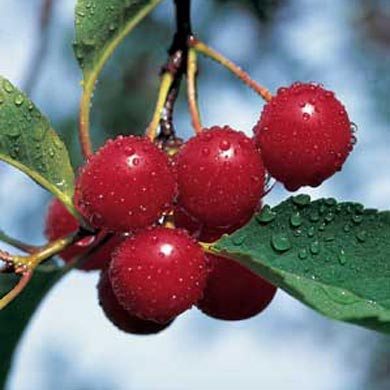Cherry Trees - Planting and Care Guide

Sweet cherries produce sweet fruit and are usually grown as small open trees or trained against walls or fences as fans. Cherry Trees can also be grown in large containers. Self-Fertile cultivars fruit without a pollination partner, acid cherries are self-fertile and tolerate some shade, and are ideal for north facing walls. Their fruits are excellent for cooking and make delicious jams.
Planting
Cherries like deep, fertile and well-drained soil with pH6.5-6.7. They do not like shallow, sandy or badly drained soils. Acid Cherry Trees tolerate some shade, and are suitable for north facing walls or fences or as open centred bush trees. Cherries grow particularly well in southern and central England.
Cherry trees grafted onto semi vigorous Colt rootstock which will restrict growth to about 6-8m (20-26ft) making large trees and are best in sunny positions in gardens. Acid Cherry Trees that are on rootstock Colt are less vigorous, growing to a height and spread of 3-3.5m. Plant Bareroot cherries from November to March.
Dig a generous planting hole. Add plenty of well-rotted manure and compost. Plant at the same depth as in the container. Tease out and spread the roots making sure the graft union is above soil level. Use a stake to support the tree for the first few years. Drive it into the hole before planting. Water well after planting. Apply deep surface mulch and a high-nitrogen liquid fertiliser in spring.
The First Year For Your Fruit Tree
Fruit trees will always appear to be strong, healthy plants when first planted, but we must remember how important it is to make sure that its new environment is a healthy one. During the first year after planting, the tree can easily die from not getting enough water or nutrients. The tree is particularly susceptible to environmental stress until the root system is at least as large as the tree it supports.
The tree must be kept well watered during the first year or two, especially during dry, hot weather. A good soaking once or twice a week is much better than surface watering daily. It is also vital to keep the area around the tree completely free of weeds and grass as they will compete with the young tree. The use of mulch mats is a very effective way to keep a nice and tidy area around the tree.
Finally, the urge to have the tree fruit is often very tempting, but the blossoms forming during the first year should be removed as they will put more stress on the tree as it establishes - and sacrificing the first year's fruit will result in a much healthier tree and better harvest in years to come.
Pruning
Sweet cherries fruit on one-year old and older wood, and pruning would create a balance between older fruiting wood and younger replacement branches. Formative pruning is done in spring as the buds begin to open, established trees are pruned from late July to end of August.
Harvesting
Pick fruits during dry weather, picking by the stalks and not the body of the fruit which will bruise easily. Eat sweet cherries fresh or store them in the fridge. Acid cherries are too tart to eat but are excellent cooked and make delicious pies, puddings, liquors and preserves.

